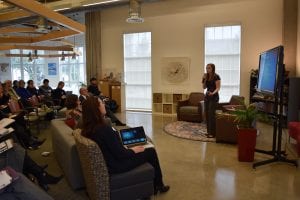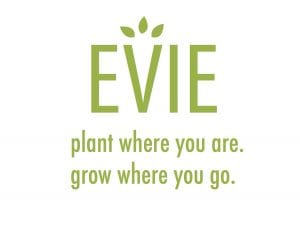 Silvia Rivera is the definition of a world changer. Since joining the Hunt Institute for Engineering and Humanity as a student analyst, Rivera has conducted research on artisan entrepreneurship and inclusive economic development. Rivera recently returned from Washington, D.C. after participating in “The Creative Economy Matters,” a conference hosted by the Artisan Alliance.
Silvia Rivera is the definition of a world changer. Since joining the Hunt Institute for Engineering and Humanity as a student analyst, Rivera has conducted research on artisan entrepreneurship and inclusive economic development. Rivera recently returned from Washington, D.C. after participating in “The Creative Economy Matters,” a conference hosted by the Artisan Alliance.
For this conference, the Artisan Alliance brought individuals from around the world together to talk about the various challenges and opportunities of investing in and creating artisan businesses. For Rivera, this was the first time that her personal ties to artisan products and academic research converged.
Throughout her childhood, Rivera visited artisan markets with her mother frequently. Even now, every time Rivera goes abroad, she makes an effort to visit small markets. These experiences have led to Rivera’s personal museum of handmade goods and tangible memories.
In college, Rivera started research at the Hunt Institute on artisanal businesses. Artisinal activity is the second largest source of income for the global poor, calls upon existing skills, makes use of available raw materials, and can help preserve cultural traditions. Rivera’s research asks, “What makes artisanal businesses successful? What makes their work impactful?” Rivera often analyzes these questions under the inclusive economy framework, a model created by Dr. Eva Csaky, director of the Hunt Institute.
“I’ll never forget it,” Rivera said when discussing the conference. “Washington, D.C. is such an energizing city.” Rivera went on to talk about her favorite speaker at the conference, DolmaKyap.
DolmaKyap, an artisan entrepreneur, shared his story of creating Chamtsee, a small handicraft workshop in Tibet. After leaving his home in search of the meaning of life, DolmaKyap noticed that people were interested in Tibet and the Tibetan way of life. He had always known that there were exceptional goods and products, like textiles and cheeses, representative of nomadic Tibetan culture. After leaving Tibet, he learned that there was demand for those goods in other parts of the world. This was the critical moment: there was an amazing good and a need in the world, what could DolmaKyap do about it? The result was Chamtsee. DolmaKyap proves that successful artisan products can generate income and represent a person’s culture.
Ideally, the impact of investing in artisanal businesses benefits everyone. By purchasing a handmade good, consumers are able to empower someone in a tangible and direct way. Artisans receive support and, in most cases, a fair wage. Consumers receive a unique product, a conversation piece, and something that is completely their own.
Do you want to start supporting artisan businesses today? The Artisan Alliance’s list of member organizations is a great place to start. Some of the members, like GAIA for Women and The Citizenry, are based in the Dallas-Fort Worth area.
Rivera acknowledges the challenges of ethical buying in general and offered this piece of advice: “A good rule of thumb I use is to just be as curious and inquisitive as possible about what you’re buying and where it came from, and to have fun with that process.”
A cursory glance at Rivera’s resume is enough to turn heads. She is a triple major in business, international studies and Spanish. She is a President’s Scholar, BBA Scholar and McLane Scholar. She has researched artisan entrepreneurship as a student analyst at the Hunt Institute for Engineering and Humanity. It’s no surprise that Bain & Company has offered her a job following her graduation in May.
According to their website, the Artisan Alliance is a network that “works to unlock the economic value in the artisan sector.” They do this through programs with innovative financing, member networking, business coaching and other events. The Artisan Alliance brings business owners, policymakers and consumers together to enact change that no business could achieve alone.
Story Contributors
Written by: Anna Grace Carey
Edited by: Maggie Inhofe







 On March 3, 2017 a rickety Shasta trailer with rotting walls rolled onto SMU’s campus. The doors were duct taped shut to hold it together. The once white siding had turned yellow after years of weathering. The two-toned orange striping on the side gave away the trailer’s mid-1980s birthday.
On March 3, 2017 a rickety Shasta trailer with rotting walls rolled onto SMU’s campus. The doors were duct taped shut to hold it together. The once white siding had turned yellow after years of weathering. The two-toned orange striping on the side gave away the trailer’s mid-1980s birthday.
 As different ideas for turning an old trailer into a mobile greenhouse floated around the Hunt Institute, one major problem remained. What should the project title be? Initially, people tried to name the project something related to SMU, but names like Peruna and Pony Up didn’t make the cut. Finally, someone suggested Evie. And it stuck.
As different ideas for turning an old trailer into a mobile greenhouse floated around the Hunt Institute, one major problem remained. What should the project title be? Initially, people tried to name the project something related to SMU, but names like Peruna and Pony Up didn’t make the cut. Finally, someone suggested Evie. And it stuck.  3Dponics is an open-source initiative that combines aeroponics and 3D printing. Aeroponics uses precise irrigation in a way that allows plants to grow without soil. This makes it possible for plants to grow in areas without good soil due to environmental conditions, urbanization or natural disasters. 3D printing using the Fused Depositions Modeling 3D Printers helps reduce the cost of complex aeroponic systems, making gardening more accessible to disadvantaged communities. Alejandro Dominguez Garcia and Alec Maulding are working on research and development for this portion of Evie: Phase II.
3Dponics is an open-source initiative that combines aeroponics and 3D printing. Aeroponics uses precise irrigation in a way that allows plants to grow without soil. This makes it possible for plants to grow in areas without good soil due to environmental conditions, urbanization or natural disasters. 3D printing using the Fused Depositions Modeling 3D Printers helps reduce the cost of complex aeroponic systems, making gardening more accessible to disadvantaged communities. Alejandro Dominguez Garcia and Alec Maulding are working on research and development for this portion of Evie: Phase II.





